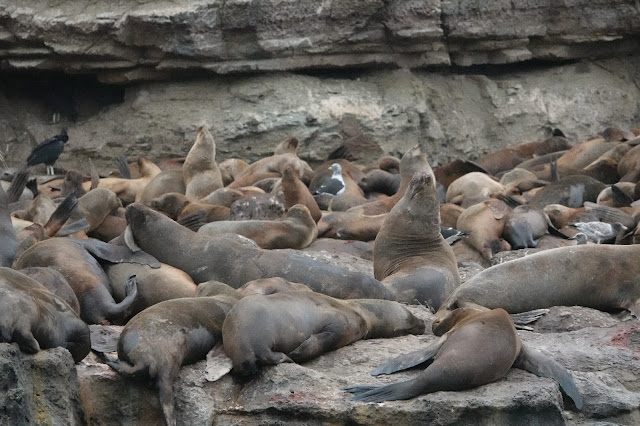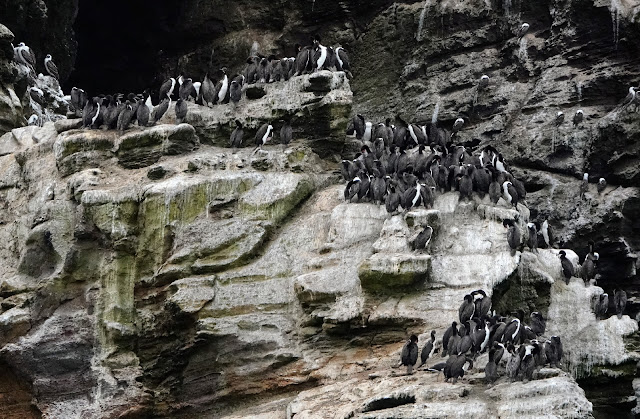I did some research and found a small fishing village just an hour south of Lima with lots of promise and tons of character. Pucusana.
It's important to arrive early, often by 11am the water becomes too rough and dangerous to be out. We arrived at 8am and quickly found a fisherman who agreed to take us out to look for birds and do some fishing. 90 minutes for 100 soles ($25 USD). The group of men we met, said all the penguins are gone for the winter, but I hoped to prove them wrong. And yes, July is winter in Peru. More on this later.
We climbed into the boat and drove thru the bay, first heading towards a tiny channel with white water crashing between the rocks. Just when we thought we may not make it thru this adventure, the fisherman turned to go the other way around the island. Whew, he was just giving us a tour of the bay first. This area is mostly low-income, however there are some fancy places along the water here, mostly used as vacation homes or Airbnbs. How fun would it be to stay in the castle!
Right away I saw a Red-legged Cormorant swimming thru the water. A bird I'd only seen once before, just a few days ago but at an incredible distance. Seeing one now up close was thrilling! I also got my first close look at a Guanay Cormorant.
Once out of the bay, we encountered the waves and suddenly the boat was listing dramatically from side to side. Now I'm no boat captain, but I'm pretty sure it helps to head into the waves instead of sideways. Luckily, we made it to the back side of the island where the "wolves" congregate. Ok, not actual wolves, these are Lobos Marinos, South American Sea Lions. But lobo translates to wolf, which really confused me earlier when reading the news about wolves on the beach!
And then we saw the birds! A single Red-legged amongst a large group of Guanay Cormorants huddled together. I scanned thru hundreds of Peruvian Boobies hoping for just one Blue-footed Booby. I scanned as best I could between the waves and the distance, but didn't see one. I snapped photos to check later before moving on.
Then I saw them, two Humboldt Penguins side by side at the edge of the cliff!
When looking thru my photos, I saw one looked like he had hearts for eyes! I then realized while most mature birds are indistinguishable, penguins have unique facial and body markings so it's easy to identify different individuals.
Now it was time to fish. As we made our way to the fishing spot, something among the rock face caught my eye. A single Peruvian Booby, but wait... just under him were two Blue-footed Boobies! Wow!
Aside from the bright blue feet, they have solid dark wings and a dirty-looking neck, while the Peruvian Boobies have a white head and neck (as seen above).
I LOVE this photo, but I do wish it was in focus. Between the distance and the listing of the boat, it was extremely challenging just to keep the bird in the frame. I have lots of photos of just heads or feet. Haha! Here's a three photo sequence of the penguins to give you an idea of just how rough it was!
To my delight, we dropped anchor and fished right there with the Boobies, plus a Red-legged Cormorant and tons of Inca Terns were just above us. Asher caught a fish on his very first cast!
I fished with my line in one hand and camera in the other and still managed to catch two fish plus a few great shots.
Back on shore we walked the main road, lined with restaurants to reach the park. There is a small inlet that water crashes thru.
There is a viewpoint on top of the mountain above the park, so we climbed up to check it out. It's much steeper than I expected.
Lunch was fresh ceviche overlooking the inlet. Afterwards we walked around the village and came across a sea lion begging a vendor for food. Dejected, he crossed the road and fought another sea lion for the fish carcass and won. I wish I captured the fight on video!
While watching them, we noticed something going on in the water nearby. Some men were tossing food from the dock to some ENOURMOUS sea lions below, and the birds were going crazy above them hoping for a piece. I was shocked to learn male South American Sea Lions can grow over 9ft long and weigh over 700lbs! These two were probably around that size!
Tuk-tuks are a common sight here.
As I mentioned, July is winter here in Peru, or more accurately, dry season, as temperatures are lower, but not by a lot. The main difference is rain, which there is very little of ever in this area. Lima is actually the second driest capital in the world, after Kairo. Thanks to the cold ocean air and the Andes mountains stripping moisture leaving this coastal region a desert. A view of hills (lomas) looking towards the Andes, on our way back to Lima.
This was such a fun and memorable day trip that we all really enjoyed!













































No comments:
Post a Comment